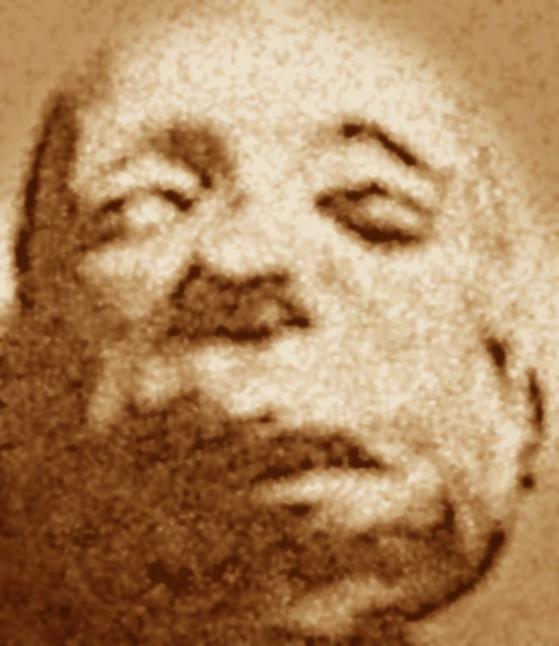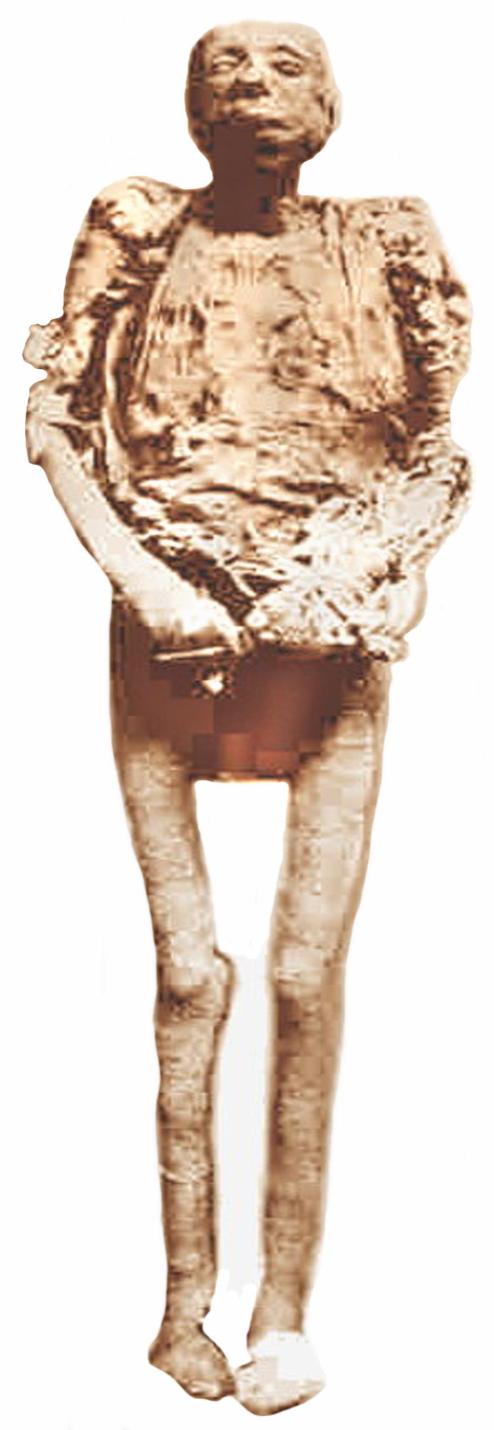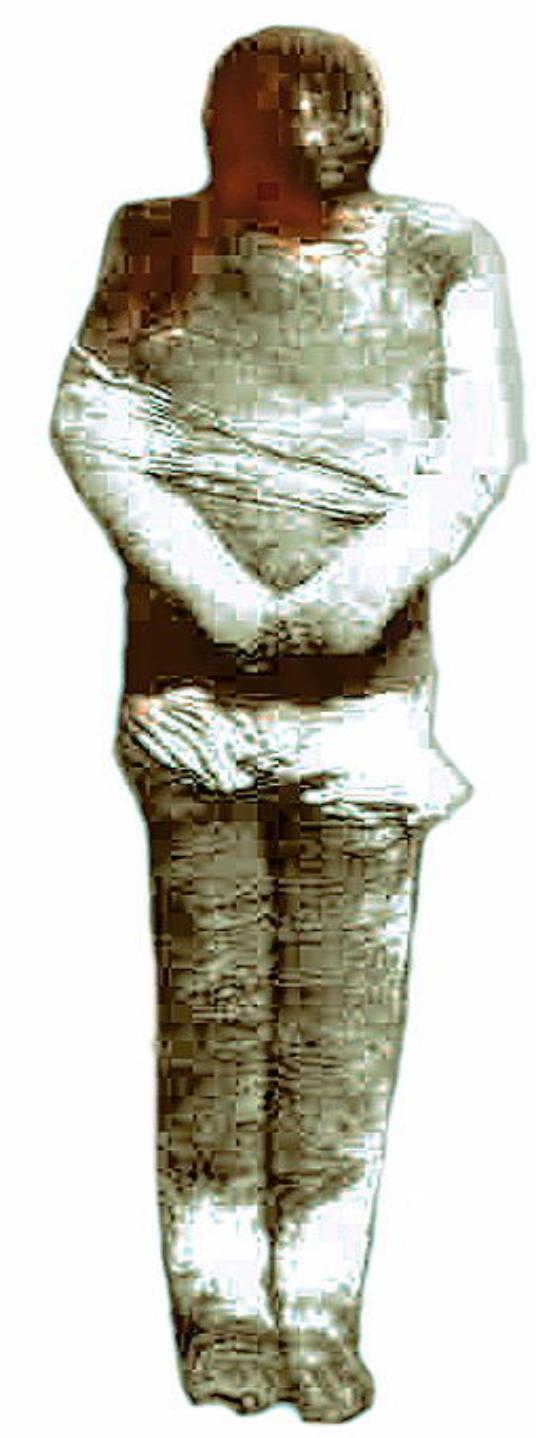Previous page Index Next page
| Russian Academy of Sciences Centre for Egyptological Studies, Moscow (CESRAS) & Russian Institute of Egyptology in Cairo (RIEC) G. Elliot Smith, The Royal Mummies, Catalogue Général du Musée du Caire, Nos 61051-61100, Cairo 1912 The Mummy of HPA and King Khakheperraw Paynedjem I Site Directory Personages Artifacts Iconography SMITH MUMMY INDEX Deities Royal Cache TT320 Network Index |
"Thumbnail" unedited scans
of Smith's original
plates.(1912) Click on image
for full-sized views.
Click here for coffin
of Smith's original
plates.(1912) Click on image
for full-sized views.
Click here for coffin
All images in sepia shades edited and digitally processed by CESRAS Research Fellow Edward R. Loring are intellectual property of the Russian Academy of
Sciences, Moscow R.F. However, they may be used freely for educational and related non-commercial purposes. If publishing such material, please give a credit to
CESRAS, Moscow. Thank you for your visit to our site and do come again. There will always be something new. If you have any comments, or if you would like to see
more details of any objects published here, please write to us at admin@cesras.org, giving your real name, institution, and title.
Sciences, Moscow R.F. However, they may be used freely for educational and related non-commercial purposes. If publishing such material, please give a credit to
CESRAS, Moscow. Thank you for your visit to our site and do come again. There will always be something new. If you have any comments, or if you would like to see
more details of any objects published here, please write to us at admin@cesras.org, giving your real name, institution, and title.
Pinodjem I, (pAynDm) son of General and High Priest of Amun (HPA) (Hm-nTr-tpy n jmnw raw) in Thebes Piankh
(pAyanx), founder of the 21a Upper Egyptian Dynasty, 1070-945, during the final years of the powerless last king of
the 20th Dynasty Ramesses XI became HPA with the latter's death and the end of the New Kingdom in ca. 1070, the
date marking the beginning of the Third Intermediate Period, 1070-ca.-750 (we count the 25th Nubian Dynasty to the
Late Period). Pinodjem's first (?) wife, Isetemkheb A, of whom we know nothing, was probably the mother of his eldest
son, Masaharta. In the 16th year of the Tanite King Smendes I, Pinodjem declared himself king with the throne name
KhaKheperrraw and Masaharta became HPA under his father. Pinodjem's second (?) and from historical
reconstructions powerful wife, Duathathor-Henuttauy bore him a daughter, Maatkaraw-Mutemhet, and a son,
Menkheperraw. Masaharta died after a 9 or 10 year pontificate during Pinodjem's reign. Discounting a very short
term, if any (?), of an ephemeral Djedkhonsefankh, the office of HPA was taken over by Menkheperraw whose reign
was to last for half a century and bring the dynasty to its highest level.
Pinodjem's remains were found in the Royal Cache TT320. His initial burial was obviously plundered and destroyed
at an early date. For his reburial at a later time unknown, a coffin of the early 18th Dynasty King Tuthmosis I was
worked over and inscribed with texts for Pinodjem. The egyptological literature, as in this case, generally speaks of
"usurping" coffins, as many persons were buried in coffins originally made for others. This has lead to the widespread
grotesque belief that mummies were often removed from their resting places, perhaps even trashed, and the coffins
taken over by a new user. I think that we should take a new look at "usurpation".
Tomb robbery is a handwork as old as Egypt itself and one which is still practiced there in our own time. However, let
us limit our consideration to the times of the later Ramessides in the 20th Dynasty. Egypt was in a period of decline
with Upper Egypt and Thebes leading the way down. The Theban necropolis still contained considerable riches and
tomb robbery became the principle source of income. Few tombs were spared this desecration. Tomb robbers were
interested in gold and jewels, materials which had a market value. Mummies often contained small objects of value
within their wrappings. The robbers were interested in these and ripped through the wrappings to find them. Coffins
were only interesting to them if they were covered with gold foil which they could adz off or had gold masks. They did
not have any use for the heavy wooden coffins and left them where they were with the torn up remains of the
mummies. Thus, there were many empty coffins to be had for the taking. These were attractive for those in the burial
business and were often taken for re-use. The re-use of an abandoned coffin is not usurpation. The ripped open and
otherwise violated mummies were often re-wrapped and hidden in various tombs.
Getting back to Pinodjem, we can only say that his mummy was found not in Tuthmosis' re-used coffin, but rather in
the coffin of Queen Ahhotep II. That was not a case of usurping either. A mummy alleged to be Tuthmosis I was found
in his (?) coffin reworked for Pinodjem. Now Pinodjem's mummy has been lost...
ERL/CESRAS/05.Feb.2012
(pAyanx), founder of the 21a Upper Egyptian Dynasty, 1070-945, during the final years of the powerless last king of
the 20th Dynasty Ramesses XI became HPA with the latter's death and the end of the New Kingdom in ca. 1070, the
date marking the beginning of the Third Intermediate Period, 1070-ca.-750 (we count the 25th Nubian Dynasty to the
Late Period). Pinodjem's first (?) wife, Isetemkheb A, of whom we know nothing, was probably the mother of his eldest
son, Masaharta. In the 16th year of the Tanite King Smendes I, Pinodjem declared himself king with the throne name
KhaKheperrraw and Masaharta became HPA under his father. Pinodjem's second (?) and from historical
reconstructions powerful wife, Duathathor-Henuttauy bore him a daughter, Maatkaraw-Mutemhet, and a son,
Menkheperraw. Masaharta died after a 9 or 10 year pontificate during Pinodjem's reign. Discounting a very short
term, if any (?), of an ephemeral Djedkhonsefankh, the office of HPA was taken over by Menkheperraw whose reign
was to last for half a century and bring the dynasty to its highest level.
Pinodjem's remains were found in the Royal Cache TT320. His initial burial was obviously plundered and destroyed
at an early date. For his reburial at a later time unknown, a coffin of the early 18th Dynasty King Tuthmosis I was
worked over and inscribed with texts for Pinodjem. The egyptological literature, as in this case, generally speaks of
"usurping" coffins, as many persons were buried in coffins originally made for others. This has lead to the widespread
grotesque belief that mummies were often removed from their resting places, perhaps even trashed, and the coffins
taken over by a new user. I think that we should take a new look at "usurpation".
Tomb robbery is a handwork as old as Egypt itself and one which is still practiced there in our own time. However, let
us limit our consideration to the times of the later Ramessides in the 20th Dynasty. Egypt was in a period of decline
with Upper Egypt and Thebes leading the way down. The Theban necropolis still contained considerable riches and
tomb robbery became the principle source of income. Few tombs were spared this desecration. Tomb robbers were
interested in gold and jewels, materials which had a market value. Mummies often contained small objects of value
within their wrappings. The robbers were interested in these and ripped through the wrappings to find them. Coffins
were only interesting to them if they were covered with gold foil which they could adz off or had gold masks. They did
not have any use for the heavy wooden coffins and left them where they were with the torn up remains of the
mummies. Thus, there were many empty coffins to be had for the taking. These were attractive for those in the burial
business and were often taken for re-use. The re-use of an abandoned coffin is not usurpation. The ripped open and
otherwise violated mummies were often re-wrapped and hidden in various tombs.
Getting back to Pinodjem, we can only say that his mummy was found not in Tuthmosis' re-used coffin, but rather in
the coffin of Queen Ahhotep II. That was not a case of usurping either. A mummy alleged to be Tuthmosis I was found
in his (?) coffin reworked for Pinodjem. Now Pinodjem's mummy has been lost...
ERL/CESRAS/05.Feb.2012
Pinodjem I as found Pinodjem I unwrapped



